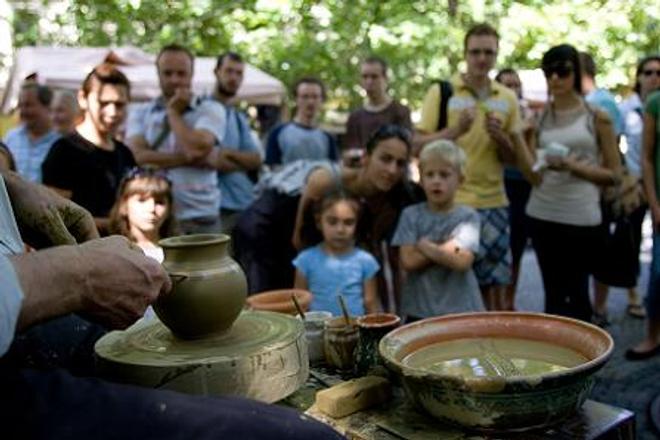The area around Bratislava has become internationally known as the home of folk majolica, a particular style of ceramics produced since the 16th century, particularly centred on the towns of Pezinok and Modra. The craft was brought to the area by the Habans, a branch of Anabaptists, who fled persecution in Germany, Switzerland and the Netherlands to settle in western Slovakia. Even though the Habans moved on, their skills transferred to local artists, who have continued the production to this day.
The products – plates, bowls and cups, as well as more elaborate figurines, etc. – are made from clay and are something between regular porcelain and terracotta. The clay is spun on a potter’s wheel, and then fired in a kiln, as usual. But then a glaze of melted glass is applied that covers the red pottery in a white sheen. Various patterns are then hand-painted onto the white coating, traditionally in greens, blues and yellows. Any red indicates a more expensive product, since the red paint is derived from gold.
In Pezinok, one of the most noted producers of majolica ceramics is Renáta Hermyšová, a former employee of a state-owned pottery company who, in 1989, when she was 20, founded her own company. Hermyšová transformed her house into a small factory and shop to create and sell her wares, now employing more than 10 people to fulfil orders received from across the world, including Japan, where she supplied ceramics to the organisers of the Nagano Olympics.
________________________________________
This article was published in the latest edition of Bratislava City Guide , which can be obtained from our online shop.For those who would like to see it online first, you can read it for free here.
________________________________________
Visitors are invited to take tours around the small factory, where they can see the production methods up close. The processes are intricate and rely very much on the skills of individual craftsmen and women; there is not a machine in sight. Rather there is a potter’s wheel and some painstaking brushwork involved in each item, before the item is stamped with an “R” and is ready to hit the shelves. In case any visitor is sceptical of the skills required to produce such items, there is even the chance to take a spin on the wheel yourself. The apron is very much recommended.
Anyone wanting to know more about the lifestyle of the Habans should head to Veľké Leváre, where a house in a former Haban village has been reconstructed in its former style and is now a museum dedicated to the enigmatic community. The Habans were similar in beliefs to the Amish of today and also lived in simple, community-oriented villages. They excelled in the seemingly diverse fields of pottery, irrigation and medicine, with many of their methods credited as the basis for modern practices.
They were, in turn, harried out of Slovakia by the Catholic Habsburgs, but some descendants remained in the village for several generations, long enough, at least, to be snapped in some terrific photographs showing the entire community posing in the village square, else hard at work.
As was typical, the house in Veľké Leváre is long and narrow, with a high, steeply pointed roof, slanting over three floors. The ground level comprises two large rooms, utilised as galleries to showcase authentic Haban clothing, as well as the machinery they used to make it, and lined by several photographs. Upstairs, the long attic-like room is a single dormitory-style bedroom, with several beds arranged in lines. Be aware, however, that at time of writing none of the museum’s signs or information panels were in English, so ask for manual in English.
________________________________________
This article was published in the latest edition of Bratislava City Guide , which can be obtained from our online shop.For those who would like to see it online first, you can read it for free here.
________________________________________

 A pottery display with a craftsman of ÚĽUV, the Centre For Folk Art Production (source: Bratislava City Guide)
A pottery display with a craftsman of ÚĽUV, the Centre For Folk Art Production (source: Bratislava City Guide)